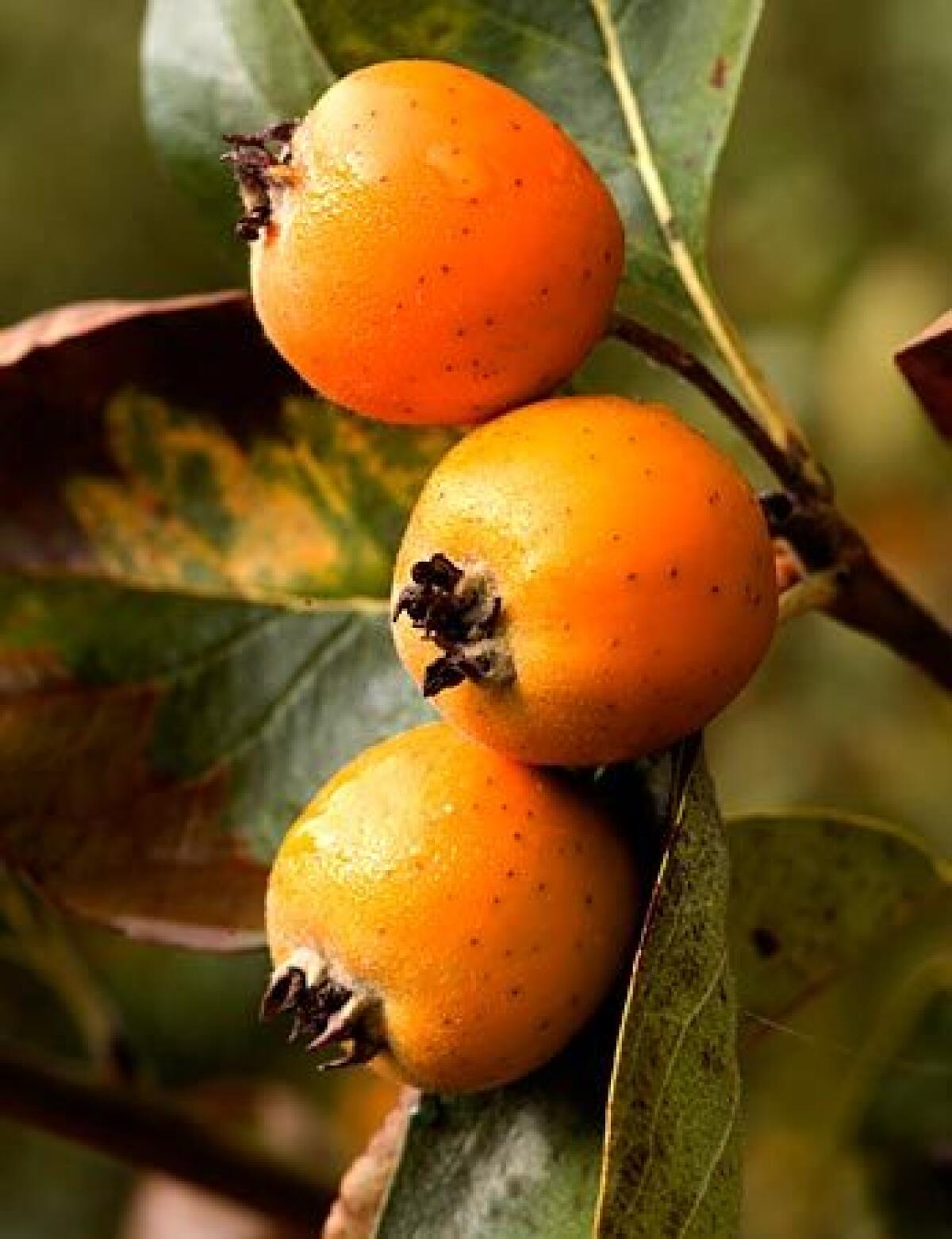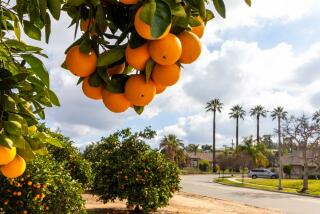Tejocote is no longer forbidden fruit

When Mexican Americans begin celebrating the extended Christmas season this Saturday on the feast day of Guadalupe, they will enjoy one big change from a few years ago: ample supplies of tejocote, a peculiar crab-apple-like fruit that most people have never heard of but that is an indispensable ingredient in ponche, the hot fruit punch emblematic of the holidays. Once the most smuggled fruit on the Mexican border, tejocote is forbidden no more.
Cheap and abundant in the Mexican highlands, tejocote (pronounced te-ho-COT-e) cannot be imported to this country because it can harbor exotic insect pests that could devastate American agriculture. So devotees of authentic ponche have had to resort to frozen or jarred or even smuggled fruit; nationwide, tejocote was the fruit most seized by the U.S. Department of Agriculture’s Smuggling, Interdiction and Trade Compliance program from 2002 to 2006, says Peyton Ferrier, an economist with the department’s Economic Research Service.
FOR THE RECORD:
Ponche Villa recipe: A Dec. 9 recipe titled Ponche Villa, which accompanied an article about the fruit tejocote, included the wrong nutritional values. These are correct: Each cocktail: 150 calories; 0 protein; 22 grams carbohydrates; 0 fiber; 0 fat; 0 cholesterol; 22 grams sugar; 7 mg. sodium. —
A decade ago, this dangerous and illicit trade was even more active. Luis Huerta, now a USDA smuggling control officer, says that in 1997, his team confiscated more than 9,000 pounds of fresh Mexican tejocotes at the produce district in downtown L.A. and other local markets.
In a roundabout way, these seizures helped inspire the creation of a lucrative new industry, after a market vendor named Doña Maria asked Huerta how to obtain legal supplies, and he suggested that farmers grow tejocotes domestically. She passed this advice to Jaime Serrato, who was familiar with tejocotes from his childhood in Michoacán, which he left at age 10 when his family immigrated to California, where his father labored in orchards.
Over the years Serrato, 53, became highly successful as a grove manager and exotic fruit grower in Pauma Valley, a lush San Diego County agricultural community north of Valley Center. In addition to farming 1,800 acres of citrus and avocados for other owners, on his own land he specialized in crops that were sought by Latino customers but that could not be imported legally, such as guavas, sweet limes and tejocotes.
Smuggled and backyard tejocote always sold for very high prices, typically $8 to $10 a pound retail, and it is unclear why no one else had seized the opportunity to grow it here. A century ago Francesco Franceschi, a renowned botanist and nurseryman, introduced tejocote to Santa Barbara; and Luther Burbank, the celebrated plant breeder, tried making crosses with the trees at his Gold Ridge Experiment Farm in Sebastopol, Calif.
But there was no commercial production in California until Serrato obtained budwood from the garden of an employee’s relative in San Diego 10 years ago and started grafting trees in his orchard.
Serrato harvested his first small tejocote crop five years ago, and today has 35 acres of trees flourishing near his hilltop home. He has experienced a few problems, but today his trees are highly productive -- mature orchards can yield 20 tons per acre in Mexico -- and he has a bumper crop this year.
Serrato sells his fruits through distributors to Latino chain stores such as Superior Grocers and Gonzalez Northgate Markets, and since prices remain high, he perhaps understates his success when he says simply, “It’s been a good thing for us.”
Tejocote is the common name for Crataegus mexicana and 14 other species of Mexican hawthorns, native to the country’s highlands; the name is derived from the Nahuatl word “texocotl,” meaning stone fruit. In Guatemala, where the fruit also grows, it is called manzanilla, meaning little apple. Hawthorns, of which there are hundreds of species around the Northern Hemisphere, are pome fruits, cousin to apples and pears and closely related to medlars.
Tejocote trees, which can grow 20 feet tall, are ornamental, with dense, shining leaves. The fruits of various kinds ripen from October to December in California, range from less than an inch to 2 inches in diameter, and vary from yellow-orange to red, often speckled with little black dots. Inside are three or more hard brown seeds. The flesh is mealy and not very tasty raw but has a sweet-tart apple-like flavor when cooked, and is rich in pectin, which contributes an appealing unctuousness to ponche.
Tejocote has been economically and culturally important since pre-Hispanic times in its homelands, where it was commonly grown in gardens and gathered from the wild. Today about two-thirds of Mexico’s production comes from commercial orchards, on about 1,680 acres, predominantly in the state of Puebla, east of Mexico City, said Carlos A. Núñez-Colín, a Mexican fruit scientist.
Serrato does not have a name for the large-fruited, thornless variety that he grows, but Núñez-Colín identified it from photographs as Pecoso de Huejotzingo (“Freckled of Huejotzingo”), the most common variety in Puebla.
The brightly colored fruits are often used to adorn Day of the Dead altars. Peeled and preserved in heavy syrup with a bit of cinnamon, tejocote traditionally provided a taste of fruit through the winter months when no fresh fruit was available, said Rachel Laudan, a food historian who lives in Guanajuato.
Ponche, which plays a role even more significant than that of eggnog in Western cultures, is served throughout the coldest months, but particularly from the Day of Guadalupe to Epiphany, on Jan. 6. It is essential for posadas, the festive processions commemorating the journey of Mary and Joseph from Nazareth to Bethlehem, which take place on the nine days before Christmas.
The three basic ingredients for ponche are tejocote (whole or quartered), guava and sugar cane, but tamarind, hibiscus flowers and piloncillo (dark brown sugar) are also typical, and almost any available fruit, like apples or oranges, can be added to the pot; some spike the drink with rum or tequila.
Tejocotes are also used in Christmas piñatas; for making jams, jellies and fruit cheese; for candying, such as for toffee apples; for extracting commercial pectin; and even for weaving into necklaces. “You hang it around your neck and eat the fruit,” said Huerta, the USDA officer.
Other growers have noted Serrato’s success with tejocote and have planted orchards of their own, on about 15 or 20 acres in total, he estimated.
Serrato considered planting more trees himself but decided against it when he heard a rumor that Mexico had applied to the USDA to export tejocote to the United States, which, if allowed, would probably lower the price his fruit commands, as happened recently when irradiated Mexican guava was allowed into this country.
In fact, Mexico filed its request in February of this year, and USDA scientists will soon begin a study called a “pest risk assessment” for tejocote, after which they will decide whether and under what circumstances it can be imported fresh from Mexico, said Larry Hawkins, a spokesman for the department.
Meanwhile, commercial tejocote smuggling has declined in recent years, said Jessica Milteer, another USDA spokesperson. It seems that demand for this curious fruit, for so long as notoriously hard to find as it was essential for traditional holiday festivities, is being satisfied through legal channels.
More to Read
Eat your way across L.A.
Get our weekly Tasting Notes newsletter for reviews, news and more.
You may occasionally receive promotional content from the Los Angeles Times.






